Keep Your Child Entertained in Nature During Quarantine
KEEP YOUR CHILD ENTERTAINED IN NATURE DURING QUARANTINE

With the warm temperatures in Summit County over the past couple of weeks, our Winter snowpack is quickly melting off and uncovering the miles of trails in the Dillon Ranger District. A fantastic way to keep the entire family entertained and educated is by utilizing the trails in our backyard to go out for an activity filled hike. Below, I will list out a number of ways that FDRD educates and entertains youth during our programming, hopefully some of these methods can be useful to you and your family.
Hikes are a great way to teach youth the importance of the 7 principles of Leave No Trace. Something that we have done is given kids cards with each of the 7 principles of Leave No Trace and ask them to point out when they see examples of violations of any one of the 7 principles. Have a discussion about all of the  principles before starting the hike. Another great game we have played with youth in the past is the trash timeline game. There are pictures of ~10 common pieces of trash that are found in the National Forest. It is the job of the kid to order the pictures of trash from shortest to longest decomposition time. More information about the Trash Timeline game can be found here. Leave No Trace is a great thing to indoctrinate in youth at an early age. They are necessary principles to keep our National Forest beautiful and pristine.
principles before starting the hike. Another great game we have played with youth in the past is the trash timeline game. There are pictures of ~10 common pieces of trash that are found in the National Forest. It is the job of the kid to order the pictures of trash from shortest to longest decomposition time. More information about the Trash Timeline game can be found here. Leave No Trace is a great thing to indoctrinate in youth at an early age. They are necessary principles to keep our National Forest beautiful and pristine.
Something I have always been particular interested in is tree identification. If you put in an hour of research online, you would feel confident identifying the differing characteristics between aspens, firs, spruce, and lodgepole pines (here is a short but descriptive article from the Forest Service detailing Colorado’s conifers). Pass this knowledge onto your kids. I would also recommend learning a couple of facts about their pinecones, growth patterns, and “why they look the way they look”. Any sort of fun fact seems to stick with the youth, try and find a couple tidbits to remember. As the youth learn more facts, ask them to identify the trees they are seeing. Work with them on this and feed into their interest if it is present.
For scientifically driven kids, there is a fun experiment involving wildfires and lodgepole pine cones that can easily be done. The cones on lodgepole pines are serotinous pines cones, meaning that the seed release occurs as a response to an environmental factor, in the case of lodgepoles: wildfires. This can easily be visualized by grabbing two lodgepole pine cones from the National Forest on a hike. Put one of the cones on a tray into your toaster oven, then turn it on to 425 degrees Fahrenheit, watch as the cone open up as the temperature inside the oven increases. Once the pinecone has fully expanded, turn off the oven and wait for the pine cone to cool. Once cooled, turn the pinecone upside down and lightly smack it on the tray, seeds should spill out of the openings. Note the wings they have on them, which allows them to float in the wind and carry the seed further. (A great demonstration of this test on YouTube can be found here) 
In order to follow the Leave No Trace principles, it would be best to bring the pinecones back to the forest. Open up the dialogue of “Are wildfires good or bad?” Give the arguments for both sides. Talk about where wildfires are positive natural occurrences, and where they can negatively impact life.
A more simple task that I have found very effective for younger children is any form of “nature bingo” or “nature scavenger hunt”. Fo r very young kids, a bingo game with colors can be a very fun activity, especially when wildflowers are present. Have different colors laid out in a 4×4 or 5×5 pattern, have the kids find as many of these colors in nature as possible. Poke a hole through the color with a small twig once the color has been found. For slightly older kids, have them find more specific items in the form of a scavenger hunt: signs of wildlife, aspen tree, signs of humans not obeying the 7 principles of Leave No Trace, moose food, etc. Make this scavenger hunt unique to the trail you will be hiking; make it relevant to what your child has learned about. This will encourage them to problem solve, ask questions, and keep them engaged. A sample scavenger hunt is shown here on the right.
r very young kids, a bingo game with colors can be a very fun activity, especially when wildflowers are present. Have different colors laid out in a 4×4 or 5×5 pattern, have the kids find as many of these colors in nature as possible. Poke a hole through the color with a small twig once the color has been found. For slightly older kids, have them find more specific items in the form of a scavenger hunt: signs of wildlife, aspen tree, signs of humans not obeying the 7 principles of Leave No Trace, moose food, etc. Make this scavenger hunt unique to the trail you will be hiking; make it relevant to what your child has learned about. This will encourage them to problem solve, ask questions, and keep them engaged. A sample scavenger hunt is shown here on the right.
For artistic kids, take a small piece of cardboard, or some paper and a clipboard. Choose a hike with a nice viewpoint and draw what you see at the end. Complete this task with your child and compare your drawings at the end. Open a dialogue about what sticks out to them; what catches their eye. Ask them if they heard any particular noises or smelled any particular smells. Encourage them to use all five of their senses. It can be very rewarding to use all five senses on a hike, so often we are caught looking down at our feet walking that we do not engage our senses and fully take in nature.
A last thing I have found to be very successful with youth is to give them responsibility. Have them plan out where the hike will be. Work with them on packing a backpack with enough water, food, sunscreen, layers, etc. for the day. Teach them how to look at a map to determine how long a hike is. Allow them to make a mileage goal for the day; what will need to be done in order to achieve this goal. I have noticed that when youth have an increased level of responsibility, their interest levels skyrocket; use this tool.
As outlined above, there are many simple ways in which to keep your children entertained on hikes during quarantine. In addition to hikes, many of these activities can be slightly tweaked in order to be relevant for your backyard or a neighborhood walk. I am sure it has been difficult to keep kids entertained during this time, but I really hope that these activities can help in some way. If you have any specific questions about any of these activities, don’t hesitate to email cam@fdrd.org.


